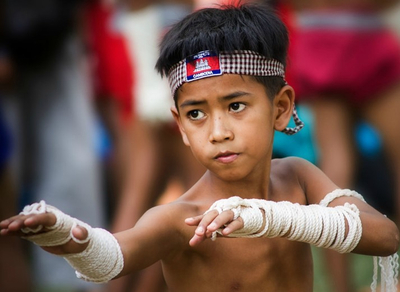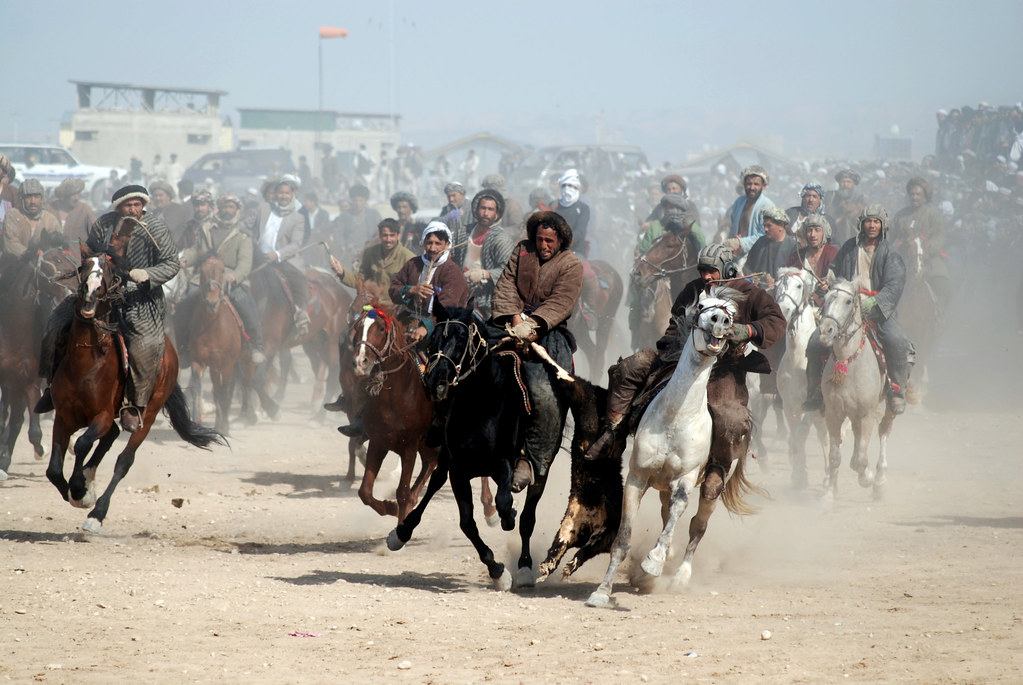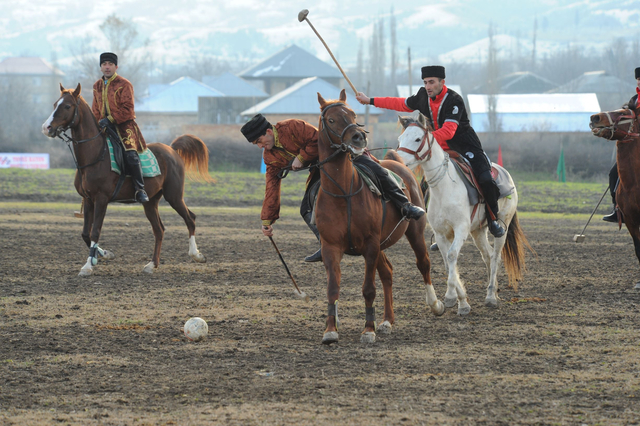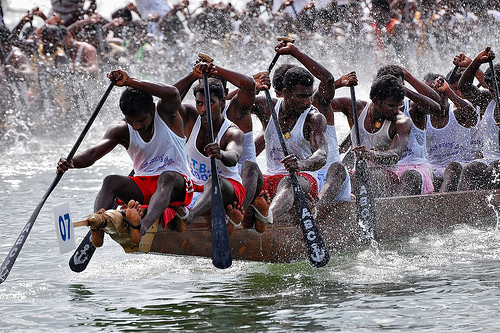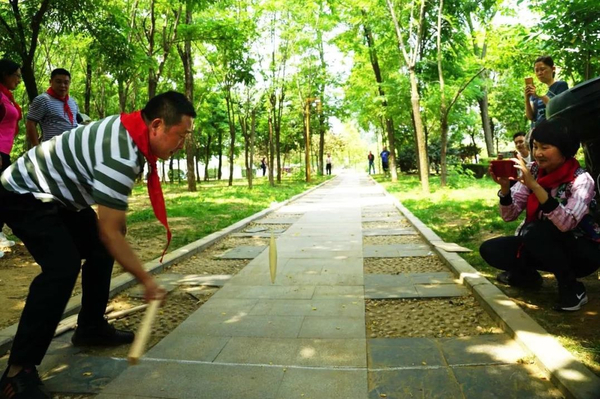- Name of sport (game): Bōjutsu
- Name in native language: 棒術
- Place of practice (continent, state, nation):
Japan
- Description:
Today bōjutsu is usually associated either with Okinawan kobudō or with Japanese koryū budō. Japanese bōjutsu is one of the core elements of classical martial training.
- Name of sport (game): Bokator or Lbokkator The term bokator translates as "pounding a lion" from the words bok meaning "to pound" and tor meaning "lion."
- Name in native language: ល្បុក្កតោ (Khmer)
- Place of practice (continent, state, nation):
Cambodia
- Village of Banteay Yuon and Sdao Chrum, Commune of Sya and Sre Sdok, District of Kandeang, Province of Pursat
- Village of Poral, Commune of Phnom Bat, District of Pornhealeu, Province of Kandal
- Urban area of Kampong Chhnang
- Village of Chres, Commune Rokakhnong, District of Daunkeo, Province of Takeo
- In the urban area and several districts of the province of Kampot
- In several districts of the Province of Svay Rieng
- Village of Tor Tea, Commune of Krabey Real, Province of Siem Reap
- Village of Thlok Chheuteal, Commune of Sopor Tep, District of Chhbarmon, Province of Kampong Speu
- Village of Khvet and Angdaung Reusey, Commune of Pong Ro, District of Roleabaea, Province of Kampong Chhang
- In several districts of the Province of Kampong Cham
- In Phnom Penh and in other provinces: Banteay Meanchey, Kandal, Preah Sihanouk, Koh Kong, Kratie, Oddor Meanchey Preah Vihear, Ratanakiri, Mondulkiri, Preyveng and Stung Treng. - History:
The ancient Khmer have practiced martial arts for 2000 years. Their country covered a significant part of Thailand, Laos and Vietnam.
According to historians, the territory of the Khmer Empire once spanned mountain ranges, rivers, lakes and seas. Men lived there together with all kinds of animals such as tigers, lions and many other carnivores. To survive, the Khmer people strove to acquire the knowledge that would allow them to adapt to nature and defend themselves against all sorts of wild animals. Many archaeological digs across the country (Laang Spean, in the province of Battambang in 1964-1968, in 2009-2010-2012 in Memot, province of Kampong Cham, in 1962-1996 and then 2004 in the pagoda of Kumnou, province of Takeo, in 1999-2001 in Prohear, province of Prey Veng, in 2008-2010 in the village of Snay, in 2006-2009 in Sophy, in 2009-2010 in Kauktreas, and in the province of Banteay Meanchey in 2013) and the results of carbon dating on the objects found during these digs, point out that people began settling in these areas as early as the Neolithic: the inhabitants of this time were already capable of defending themselves and their communities; they possessed well-established beliefs including respect for the dead, to which they made offerings.The first traces of the Bokator, fighting scenes, strangulation techniques and strokes are found on Angkor reliefs, especially in Banteay Srey, in the tenth century they practiced martial arts of Indian origin (Sri Lanka or Kerala) called Maloyuth.
To survive, the Khmers passed down knowledge and tactics from generation to generation to protect their community and customs, which became traditions. This knowledge, which enabled them, in particular, to fight wild animals, was illustrated in sculptures on the walls of many temples such as Sambor Prei Kuk, Koh Ker, Baphuon, Bayon, Preah Khan, Banteay Chhmar, etc. Furthermore, a very great number of bas-reliefs in the temples of Angkor relating the legends of the Ramayana and the Mahabharata describe these combat techniques practiced in the actual lives of the people of the Khmer Empire. Still later, the frescos of the Kampong Tralach pagoda, erected in the early 20th century in the province of Kampong Chhnang, which can still be admired today, illustrate scenes of combat during traditional festivities in which combatants can be seen using their bare hands and feet, as well as sticks. The Khmer ancestors gave the name “Kun Lbokkator” to all these combat techniques.
- The term KUN describes the martial art of fighting, leaping, and confronting opponents according to the techniques specific to the warriors of the Khmer Empire (Venerable Chuon Nat, p. 137);
- The term LBOKKATOR refers to all combat techniques involving the half-kneeling position, neither too high nor too low. Kun Lbokkator is based on 12 positions. The combination of the various positions forms a specific combat technique. The term Kun Lbokkator is also present in Khmer literary works. According to the Khmer dictionary of the Venerable Chuon Nat, page 1,138, the term LBOKKATOR means a sort of short stick spanning the distance from elbow to hand used as a shield against the long staff of an opponent, or a combat technique using this short stick.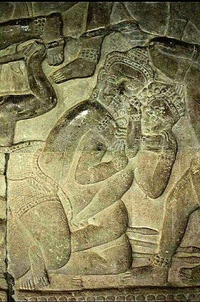
Bokator or L'bokator is a Khmer martial art that includes weapon techniques. One of the oldest existing combat systems in Cambodia, oral tradition indicates that the Bokator or its early version was a melee combat system used by the Angkor army 1700 years ago.
It is said that the boxer is the earliest systematized Khmer martial art. The name l’Bokkatao comes from Sanskrit, so it is thought to be native in India, like the Khmer culture. The pronunciation of the word "bok-ah-tau" comes from labokatao, which means "to hit the lion." This refers to a story that took place 2000 years ago. According to legend, the lion attacked the village, when the warrior, armed only with a knife, defeated the animal with his bare hands, killing animal with one strike at the knee.
Although the lion has cultural significance to Indochina, modern literature assumes that this was not the area of occurrence of the Asian lion, which currently lives in western India. Instead, large cats from Southeast Asia are an Indochina leopard and a tiger.
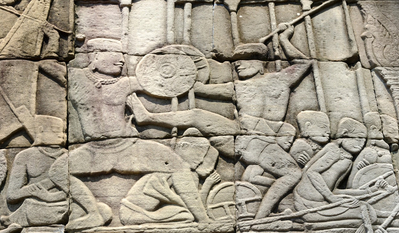
Indian culture and philosophy were the main features which had an influence on the culture of Angkor. All large Angkor buildings are dedicated to Hindu gods, especially Visnu and Shiva. Even today, practicing Bokator start each training session with respect for Brahma. Religious life was dominated by brahmanas, who also practiced sword fighting and empty hand techniques in India. The concept of animal-based techniques most likely appeared during the reign of the Angkor kings and during the simultaneous influence of Indian martial arts.
The reliefs at the base of the entrance pillars to Bayon, the state temple of Jayavarman VII, depict various Bokator techniques.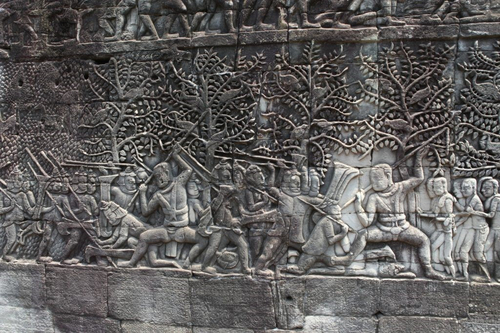
The Khmer Empire was huge, which meant that many martial arts were practiced on its territory. Hence the difference between Kun Khmer and Muay Thai is small. Style and strategy are slightly similar, although the rules are different. The use of elbows is preferred in Kun Khmer. Kun Khmer's warriors will be more looking for opportunities to strike an enemy to shorten the fight distance than wins for points.
Historically, Thai people have come to the present territory since the eleventh century, while the Khmers have been there since at least the first century AD with the kingdom of Funan. The Thai people were vassals of the Khmer Empire and worked as mercenaries until independence and victory over the Khmer in the fourteenth century. That is why they adopted the fighting techniques practiced at that time by Khmer and Mon (people practicing Burmese boxing) and appropriated Khmer culture along with the alphabet, dance, martial arts etc. Therefore, Cambodian boxing has many similarities to Thai boxing, because they both come from the same martial art.Bokator was the main basis of the martial arts used by Khmer ancestors when fighting their enemies. More recent research is showing that after the arrival of ammunition-firing canons, Bokator became a performing art or traditional leisure game, practiced during traditional festivities such as the Day of the Dead, the Buddhist Solidarity Festival (Kathin), the Khmer New Year, etc. A large number of Bokator fighting techniques have become essential building blocks for other forms of art and the performing arts: classic and folklore dances such as Toam Ming, Kantèrè, Bokleakh, Chhay Yam, Robaim Kbach Kun, and some combat scenes of Bassac theatre.
Although Cambodia was, during the centuries following the fall of Angkor, burdened by wars, Bokator remains and continues to survive within Khmer society. Master practicing in communities, certain pagoda venerables, instructors, supporters, national television networks, film producers, several Ministries of the Royal Cambodian Government and their provincial Departments, national and international sports clubs (in the United States, France and Canada in particular) are unanimous in their will to support and promote Bokator.
From the 17th century until 1953, Cambodia experienced many political turmoils. The element bearers and local authorities encouraged the defence movements in communities and formed militia groups. Bokator training and learning were organised for the villagers. The French Protectorate authority (1863-1953) even presented the best Bokator (stick or bare-handed combat) practitioners to the public during the French and Cambodian national festivities.
After 1953, the authorities continued to encourage Bokator learning and training, extending some of the combat techniques to other forms of sport such as modern Khmer boxing and traditional Khmer boxing and establishing national and international combat standards.
All the efforts and measures relating to bokator were entirely annihilated, the human resources decimated and documentation entirely destroyed by the genocidal Khmer Rouge regime. Some knowledge bearers that survived were able to reconstitute a partial knowledge of the element.
After the fall of the Khmer Rouge, the few masters who escaped pooled their knowledge to transmit it to new generations. However, the lack of opportunities and means significantly restricted transmission of their knowledge at a period when the war-ravaged country strived to rebuild itself.
The Ministry of Culture and Fine Arts of Cambodia conducted research to gather documentation on Bokator, inventorying 76 high-level practitioners and offering them the opportunity to transmit their knowledge. In collaboration with several television networks, Bokator performances and historical documentaries were broadcast.
The relevant public institutions also conducted research to document Bokator and form Bokator clubs. Competitions were organised at a national and international level. In 2010, Cambodia participated in the "Chungju World Martial Arts Festival" in South Korea.
Private partners, especially film and television programme producers started to show interest in Bokator to stage performances for audiences and make it part of their scenarios.
The Living Treasure system adopted in Cambodia did not include any Bokator masters amongst its 17 first nominations, completed by Royal Decree.
Since 2012, the Ministry of Culture and Fine Arts has been conducting an inventory of all masters, clubs, communities and potential pupils with a view to organising sustainable programmes to safeguard and transmit knowledge to future generations.
It may ,therefore, be observed that despite the efforts implemented, there is a true need for a precise, coordinated programme to safeguard this traditional martial art.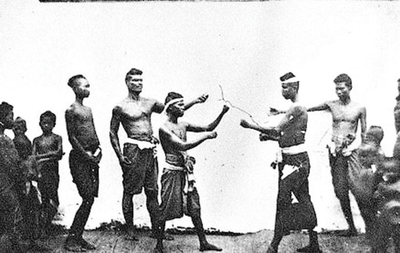
- Description:
Bokator is the general name for all Khmer martial arts: Kbach Kun Boran
Khmer - ក្បាច់គុនបូរាណ, which include:
1) Atmani Yuth – forms of fight with bare hands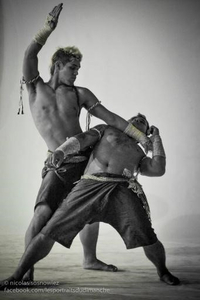
In which you can distinguish:
- Kun Khmer (គុនខ្មែរ) – boxing
- Baok Chambab (បោកចំបាប់) - wrestling
The Atmani yuth boxing comes from Kun Daï. Kun Khmer, which means that Khmer art is a modern name meaning Khmer boxing, which will replace pradal serey.2) Ani Yuth –forms of fight with weapons
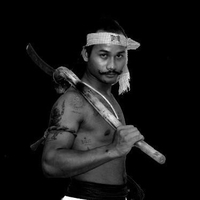
In which you can distinguish:
- Kbach Kun Dambong veign (ក្បាច់គុណដំបងវែង) – long stick fight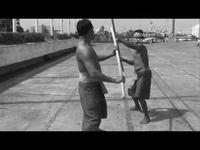
- L’Bokkatao (ល្បុក្កតោ) – fight with use of Kun Khel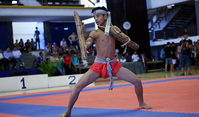
- fight with the sword, short stick etc.
Currently in Cambodia there are many Bokator schools of martial arts and Kun Khmer, and their largest concentration is in Phnom Penh and several in Siem Reap.
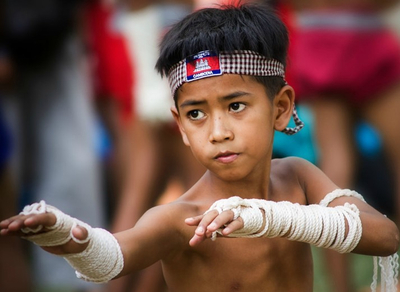
A common misunderstanding is that the Bokator refers to all Khmer martial arts, while in reality, he represents only one particular style. The competitor uses diverse punches of elbow and knee blows, shin kicks, dodges and ground floor fighting.
During the fight, Bokator champion still wears the clothes of ancient Khmer armies. The krama (scarf) is wrapped around the waist, moreover, a blue and red silk cord called "sangvar" is tied around the head and biceps. In the past, it was thought that cords had power and were put on to increase strength, although now they are only ceremonial.It should also be noted that the term Bokator is the master San Kim Sean’s choice (also the Cambodian sport ministery’s and the Cambodia Olympic Comitee‘s choice) to designate all traditional Khmer martial arts Kbach Kun boran Khmer (weapon techniques, supplies, etc.) except boxing (Kun Khmer) in commercial will and simplification. Because there are many martial arts in Cambodia, to simplify all this and facilitate expansion, the term Bokator (even Kun Bokator) was chosen.
The art contains 341 parts, which, like many other Asian martial arts, are based on observation of life in nature. For example, there are styles of horses, birds, eagles and cranes, each includes several techniques. Due to the visual similarity, the Bokator is often mistakenly described as a variant of modern kickboxing. Many forms are based on traditional animal styles, as well as simple practical fighting techniques. “Pradal serey” is a more condensed combat system that uses some basic techniques (white krama) to hit by using the elbow or knee and is without any animal styles.
Krama shows the advancement level of the warrior. The first level is white, followed by green, blue, red, brown and finally black. After completing the initial training, competitors wear black krama for at least another ten years. After the black krama there are also "dan", which in Khmer is called Tchouan, and a special krama, including a gold and a diamond. To reach the golden krama, you must be a real champion and do something great for the Bokator. This is certainly a time consuming and perhaps life-long undertaking: in the very part of martial arts without weapons, there are from 8,000 to 10,000 different techniques, of which only 1,000 need to be learned to reach the black krama. The practice includes the use of weapons, forms (tvear), animal techniques, standing combat, ground fighting and wrestling. Each of the first six contains tvear and the need to overmaster:
• Attack techniques, eg: feet, elbows, knees.
• Defense techniques.
• Animal movement techniques (Sath) and combat techniques (Maekun Veybok).
• A kun kru (ritual dance before the fight).Each level has its own difficulties, the higher the level, the more content. The duck and horse technique are white krama techniques necessary to obtain a green krama. The same applies to the techniques of Preah Noryeille (Vishnu), these are blue krama techniques to obtain a red krama.
All hard parts of the body are used in the Bokator: fists, feet, arms, head, knees, and elbows.
In Cambodia, there are regular competitions such as SEA GAMES in Phnom Penh.
The competitors compete in two categories:
- techniques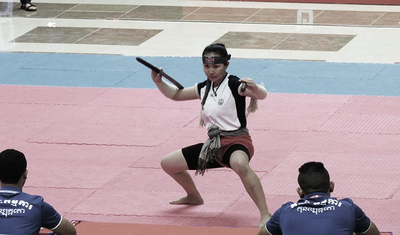
There are technical competitions in which the practitioner presents his tvear (kata,form), with bare hands or with a weapon (short stick, long stick or khel). The judges pay attention to the aesthetics of the movements and the quality of the exercises.
- fight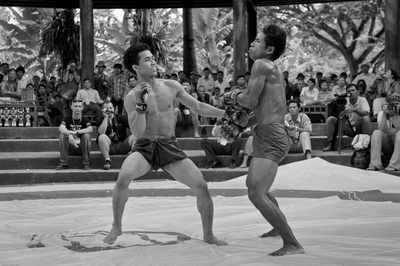
The fight takes place in a circle, in 5-minute rounds, and the players are accompanied by music (different from muay thai and kun khmer). All strokes are allowed except for strikes on the ground, neck, back and genitals. The referee quickly stops the fight when the players are on the ground if one is not moving. Of course, bites and sticking fingers in the eyes are also prohibited.
Fighters dance between each phase of the fight. There is an old legend which says that warriors who fought against animals performed a dance to enchant them and better neutralize. - Current status:
During the Pol Pot regime (1975–1979), those who practiced traditional Bokator art were either systematically exterminated by the Khmer Rouge, escaping as refugees, or stopped teaching and start hiding. After the Khmer Rouge regime, the Vietnamese occupation of Cambodia began and local martial arts were completely banned. San Kim Sean is often called the father of the modern Bokator and thanks to him this martial art has been largely preserved and spread. In Pol Pot's time, San Kim Sean had to flee Cambodia on charges of teaching hapkido and Bokator. In America, he began teaching hapkido at the local YMCA in Houston, Texas, and later moved to Long Beach, California. After living for some time in the United States and teaching and promoting hapkido, he discovered that no one had ever heard of a Bokator. He left the United States in 1992 and returned home to Cambodia to restore the Bokator tradition. In 2001, San Kim Sean moved back to Phnom Penh and after receiving permission from the new king, began teaching the local youth. In the same year, hoping to gather all the remaining living masters, he began to travel around the country looking for a Bokator lok kru or instructors who survived the regime. The few people he found were old, sixty to ninety years old, and tired of 30 years of oppression; many were afraid to teach art openly. After many persuasions and after the approval of the government, the old masters gave way and Sean successfully restored the memory of a Bokator to the people of Cambodia.
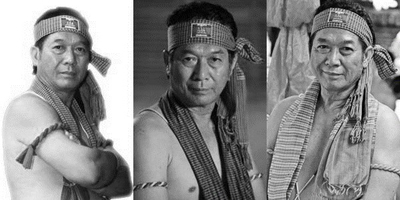
Contrary to popular belief, San Kim Sean is not the only labokatao master who survive. Others are Meas Sok, Meas Sarann, Ros Serey, Sorm Van Kin, Mao Khann and Savoeun Chet. The first national Bokator competition in history took place in Phnom Penh at the Olympic Stadium on September 26-29, 2006. 20 leading teams from nine regions took part in the competition.
In Europe, the Bokator is becoming more and more popular. Important people who popularizing this sport are:
François Moreau, like most practitioners in France he started with judo and then with Ju-Jitsu. He practiced boxing at the age of 17, kick-boxing and Full-contact. He later discovered Kung fu, perfecting himself in Sifu Gao Shikui in the style of a praying mantis: boxing Tang Lang. He obtained a black belt and an instructor diploma. At the same time, he practices Muay-Thai, Kun Khmer (Cambodian boxing) and Pancrace. He fights in each of these disciplines. He has the title of vice-champion of France 2004 and champion of France 2005.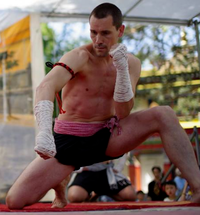
Christophe Chiv, nicknamed Nak, began practicing martial arts from taekwondo at a small traditional club in Saint-Denis (France) at the age of six. He also practiced Shotokan karate, and at the age of 15 he decided to start boxing and kick-boxing. He appeared on the ring for the first time at the age of 16. He practices Kun Khmer (Cambodian boxing) and Bokator (Cambodian martial art).
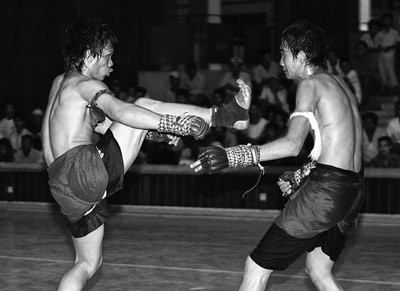
- Importance (for practitioners, communities etc.):
Bokator is one of the key elements represented in Cambodia’s world heritage sites: the Angkor temples and the Temple of Preah Vihear. On an equal footing with the Royal Ballet and Sbek Thom (shadow theatre), Bokator is exclusively part of Cambodia’s intangible cultural heritage and is closely related to world heritage. While it may be said that the temples, which may be equated with the body, have been preserved, it is just as important to save the soul and spirit of this heritage. Bokator, carved into the bas-reliefs of the world heritage temples, deserves an emergency safeguarding programme in order to highlight the intangible aspects of world heritage.
Bokator is one of the most physical illustrations of the customs, traditions and knowledge of the everyday life of the ancient Khmers regarding defence against wild animals and invaders.
Bokator was part of the country’s national identity at the time of the Khmer Empire and also constitutes a key historical element in the fight to defend the Empire. This element can therefore not be ignored in studies and teachings about the history of Cambodia. Implementing an appropriate safeguarding programme is, therefore, an urgent matter before this element disappears or looses its initial form.
Nearly all bearers - Bokator masters - are generally more than 75 years old. Their health is very fragile and their memory not always very clear. Many of them are beginning to forget the important aspects of Bokator. Others are already dead and are soon to be followed. Some are mobility-challenged and are no longer capable of performing a full demonstration to their pupils.
As few young people show interest, there is a real shortage of human resources to renew Bokator. - Contacts:
Cambodia Kun Bokator Federation
Phnom Penh
+855 Phnom Pen, Cambodia
https://www.facebook.com/KunBokatorFederation/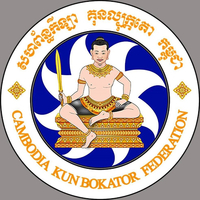
Surviving Bokator
+1 416-616-4251
www.survivingbokator.com
https://www.facebook.com/bokatorfilm/Bokator Cambodia
https://www.facebook.com/Bokator-Cambodia-171150479572441/?eid=ARD4U4zL4CZwIi0xryAOdWq1zdoQux0qri9CqCkjID7XBPUMhhhoZyMmYUyRg_2aJ7AiAXx0_57TI8ORFederation Khmer Sak Yant
http://federationkhmersakyant.com/
(+855) 97 83 80 844 (Teven)
(+855) 86 200 253 (Sotun)Fédération Européenne de Bokator
https://www.facebook.com/federationeuropeennebokator/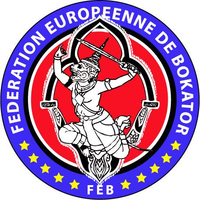
Australian Bokator Association
+61 401 004 045
Seng 0401 004 045
Heng 0411 731 218
John 0400 121 036This email address is being protected from spambots. You need JavaScript enabled to view it. This email address is being protected from spambots. You need JavaScript enabled to view it. 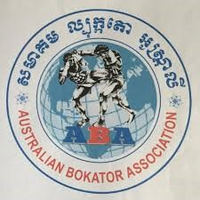
Iranian Bokator Association
https://www.facebook.com/IranianBokatorAssociation/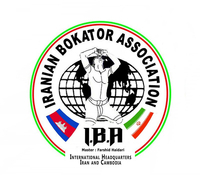
Bokator Academy
https://www.facebook.com/Bokator-Academy-Phnum-Phen-210787102360197/
+855 97 702 4523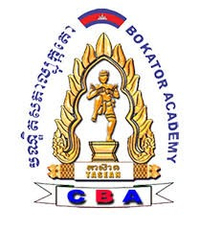
Leak Rayong Bokator
https://www.facebook.com/KhmerMartialArt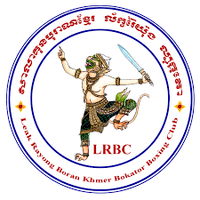
Midle East
https://twitter.com/mekf_mebf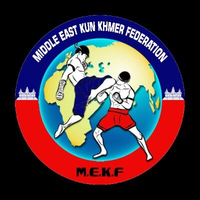
Bokator Fight
+855 10 904 074
https://www.facebook.com/Bokator-Fight-174109282649881/UP Bokator Club
https://www.facebook.com/BokatorPuthisastra/
#55, Street 180-184, Sangkat Boeung Raing, Khan Daun Penh
12000 Phnom Penh
+855 87 752 998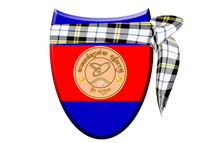
Bokator Morodok Khmer
https://www.facebook.com/bokatormorodok.khmer/
126 street 598,Toul Kork, Phnom Penh
Phnom Penh
+855 17 728 347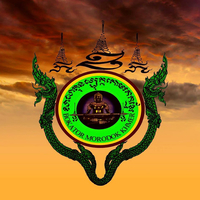
La Bokator A.K.A Khmer Martial Arts
Email:This email address is being protected from spambots. You need JavaScript enabled to view it.
Phone: (562) 230-5731
Address: 1321 E Anaheim St, Long Beach, CA 90813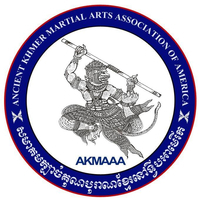
- Sources of information :
Books, articles:
Ang, C., La lutte et d'autres jeux de physique. Recueil des articles de presse sur la Culture khmère, No1., 2005-2006
An, C. H., Lbokkator et les arts du spectacle. Phnom Penh, 2012
Chuon, N., Dictionnaire khmer-khmer. Phnom Penh, 1967
Chey, V., Khmer traditional boxing. Southeast – Asian culture year 2004
Chuch, P., Fouilles archéologiques à Snay. Centre de recherche international du Japon, Yooshinori Yasuda, 2008
Daim, T., Les épisodes de la galerie intérieure du temple de Bayon. Mémoire de Licence. Faculté de l'archéologie. Phnom Penh, 2005
Heng, S., Forestier, H., Le site archeologique de Laâng Spean. Rapport sur la première fouille archéologique, 2009
Im, S., La vie du peuple khmer après l'époque angkorienne à travers les sculptures sur les bas-reliefs du temple de Bayon. Mémoire de Licence. Factulté de l'archéologie. Phnom Penh, 1995
Iv, P., Les épisodes de la galerie extérieure du temple de Bayon. Mémoire de Licence. Faculté de l'archéologie. Phnom Penh, 2004
Khiev, Ch., Seng, S., Le temple de Banteay Chhmar. Mémoire de Licence. Factulté de l'archéologie. Phnom Penh, 1997
Khing, H., La fable d'Angkor. Littérature et civilisation khmères. Librairie d'Angkor, 2006
Leclere, A., L'histoire du Cambodge. Paris, 1914
Meas, S., L'héritage des arts martiaux khmers. Phnom Penh. Vol. 1., 2011
Oreilly, D., A Compendium of Archaeological Research Undertaken in Cambodia. University of Sydney Australia, 2009
Nou, S., Rapport de la recherche sur les arts martiaux khmers. Département du Développement culturel. Ministère de la Culture et des Beaux-arts, 2007
Roath, S., La Boxe khmère, 2012
Sam, A., Preah Chan Korup. Institut bouddhique. Phnom Penh, 1833
San, K., Khmer Martial Arts-Boxkator History 2000 years. Angkorian Traditional Martial Art. Bokator Competition Rule. Phnom Penh, 2004-2008
Sok, Th., L'histoire des arts martiaux khmers. Département de la Culture et des Beaux-arts de la province de Kampong Chhnang, 2012
Taing, Rinith, The Kingdom’s oldest wrestling form grapples with fading interest, The Phnom Penh Post, 7 Apr. 2017, retrieved 21 Apr. 2017
Vanna, Ly, Khmer Traditional Wrestling, Leisure Cambodia, August 2002, retrieved April 21, 2017
Vogel, S., 2009. Aspect de la culture traditionnelle des Bunong du Mondulkiri. Phnom Penh.
WOMAU News, The World Martial Arts Union 2009 become a NGO in operational relation with UNESCO.
World Martial Arts Union (WOMAU) W.M.A.F Promotion Committees 2010.Articles (web):
http://federationkhmersakyant.com/bokator--khmer-martial-arts.html
http://blog.aseankorea.org/?p=4072
http://www.taipeitimes.com/News/editorials/archives/2007/10/14/2003383133
http://www.talesofasia.com/rs-99-bokator.htm
https://theculturetrip.com/asia/cambodia/articles/bokator-the-history-of-traditional-khmer-martial-arts/
https://www.khmertimeskh.com/506074/the-lady-is-a-bokator-fighter/
http://www.fullcontactmartialarts.org/bokator-khmer.html
https://www.scmp.com/lifestyle/article/2142056/ancient-martial-art-spawned-muay-thai-undergoes-rebirth-cambodia-thanks
http://www.leisurecambodia.com/news/detail.php?id=113
https://www.phnompenhpost.com/arts-culture/kingdoms-oldest-wrestling-form-grapples-fading-interest
http://www.rfi.fr/hebdo/20180406-surviving-bokator-cambodge-documentaire-art-martial-khmer-rougeVideo:
https://vimeo.com/284746421?fbclid=IwAR25qBLZePl1vasUqv3QmOcfXEyg_jUYbVTGs54R2znvBU1X84TR3aZQme8
https://www.youtube.com/watch?v=RalqHrCChWI
Martial Arts Odyssey: Bokator: The Khmer Martial Art Parts 1: https://www.youtube.com/watch?v=Gobc3zSjXZU
Martial Arts Odyssey: Bokator: The Khmer Martial Art Parts 2: https://www.youtube.com/watch?v=KBwvwThib5s - Gallery:
- Name of sport (game): Boke also Bokh
- Place of practice (continent, state, nation):
Mongolia
- Name of sport (game): Bultong
- Place of practice (continent, state, nation):
Philippines
- Name of sport (game): Buno
- Place of practice (continent, state, nation):
Philippines
- Name of sport (game): Buzkashi or Oglak Tartis
- Name in native language: Persian: بزکشی (bozkaszī), Tadzhik: бузкашӣ (buzkaszī), translation: "goat pulling"
- Place of practice (continent, state, nation):
Part of Asia (Kazakhstan, Kyrgyzstan, Tajikistan, Uzbekistan, Turkmenistan and northern Afghanistan), mainly in mountainous areas.
- History:
Sport was created in the 13th century. Most likely in Mongolia during the Chyngis Khan's reigns. In the past, very often a wolf had kidnapped a sheep from a herd. Then the shepherds start a pursuit to catch the animal, when they bag a wolf, they cut its throat. In that, they earn respect among other shepherds and interest among the fair sex. Most likely, due to the lack of wolves, goats are used for the game.
When in 1996 the Taliban began to rule in Afghanistan, buzkashi became forbidden. After the fall of the regime in 2002, the game became legal again.
Around the most important royal buzish competitions taking place in Kabul, the story of Joseph Kessel's book "Riders" (French: Les Cavaliers) and the films based on it from 1956 and 1971 takes place. Moreover,Buzkashi was featured in Rambo III (1988) when Sylvester Stallone was actually seen playing the game.
In the 1940s, a group of men in Cleveland, Ohio introduced a version of the game in the United States. They called the game “Kav Kaz.” It only lasted for less than a decade.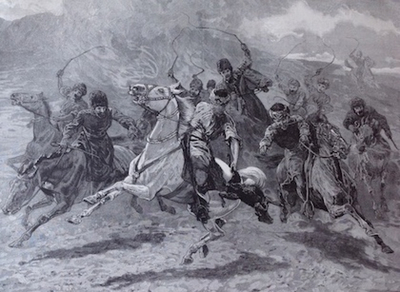 "Herati horsemen playing the 'Baz Gadeh Bazi' or goat-neck game. Scenery and life in Afghanistan," from sketches by Sir Edward Durand. The Graphic, 23 September 1893, p. 377.
"Herati horsemen playing the 'Baz Gadeh Bazi' or goat-neck game. Scenery and life in Afghanistan," from sketches by Sir Edward Durand. The Graphic, 23 September 1893, p. 377.
Source: https://trc-leiden.nl/trc-digital-exhibition/index.php/afghan-dress/item/89-buzkashi-garments - Description:
Two teams of riders on horseback take part in the game. In unofficial games, there is no predetermined number of players, whereby additional players can join in the playing team. The task of the players of each team is to pick up a body of a goat with cut off head which lies in the middle of the field on marked circle (nowadays instead of the body of a previously killed animal, a loaded bag made of lambskin or calf is used), transported around the field and dropped to "Goal", which are marked by circles on the earth. The task of the opponents is to take "the ball" away from the opponents, transport it around the field and throw it into the circle of rivals.Sometimes in order to make the game difficult, the previously prepared bag is soaked for several days in ice water, making it heavier and harder to maintain.
There are hardly any rules in the game. It is allowed to beat a horse or rider, kept (often in teeth) with small whips (knouts), pushing and knocking off a horse. There are no reminders or penalties. In the game, players must demonstrate exceptional physical fitness, dexterity and cunning.
A buzkashi player is called a Chapandaz; it is mainly believed in Afghanistan that a skillful Chapandaz is usually in his forties. This is based on the fact that the nature of the game requires its player to undergo severe physical practice and observation. Similarly horses used in buzkashi also undergo severe training and due attention. A player does not necessarily own the horse. Horses are usually owned by landlords and highly rich people wealthy enough to look after and provide for training facilities for such horses. However a master Chapandaz can choose to select any horse and the owner of the horse usually wants his horse to be ridden by a master Chapandaz as a winning horse also brings pride to the owner. The horses are more valuable in a game of Buzkashi than the player himself. In some cases, a horse may be trained for up to 5 years before playing its first game., They can protect the rider with their own body, when this falls during the fight.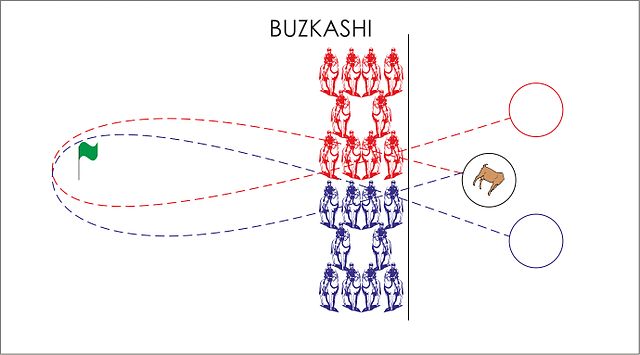
Buzkashi in Afghanistan
Buzkashi is played in Afghanistan in two types:
Team play :
Most famous team from each province will be selected for these competitions and on the field their will be 6 horses from each side on the competition day the game is played for 3 period of 25 minutes.
Group play :
In this type their will be more than 50 horses on the field, and every body will score for their own and take the prize, the owner of horses will gave some money or anything precious for player to encourage them.
Field in Afghanistan has 2 circle for putting the selected animal, and one circle for taking and also a flag on another side of the playing field.
Players must take the animal form circle and go to flag and after turning around the flag then back to the putting circle and put the animal.
Buzkashi is played on winter time on cold weather usually on Friday and on Monday’s small players play on field.
The biggest event of Buzkashi every year held in Mazar e sharif center of Balkh province by the name of ( Mila e gol e sorkh ) which means the red flower party in last days of March, in this event teams come from all over of Afghanistan and try to be the winner.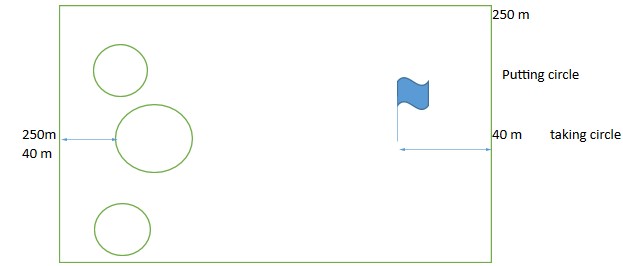
For official games (eg for tournaments in Kabul), the Afghanistan National Olympic Committee has established the following rules and provided penalties:
-The pitch has shape of square, each side is 400 meters long.
-Each team consists of 10 riders.
-Only 5 players can play in each half.
-Half takes 45 minutes.
-The break between takes 15 minutes.
-A judge is watching over the game.
The different types of Buzkashi: Tudabarai & Qarajai
In Tudabarai, in order to score, the rider must obtain possession of the carcass and then carry it away from the starting circle in any direction. The rider must stay free and clear of the other riders.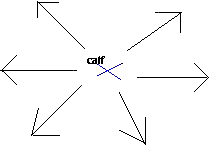
In Qarajai, the task is much more complex. The player must carry the calf around a marker, and then return the carcass to the team’s designated scoring circle.
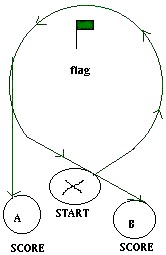
- Current status:
Sport is practiced all the time. Official matches are organized due to various national and other holidays, for example on the occasion of the first day of spring, New Year or Independence Day.
Unofficial matches are organized by ordinary people, e.g. due to circumcision of a son or a wedding. The organizer usually provides rewards for all participants of the game. The richer the family is, the better rewards are, so sometimes you can win a camel, laptop or just money. Information about them [about matches] is given in secret and carried by word of mouth.
There are some organizations, like in Afghanistan there is the Buzkashi Federation.
Every two years, the Nomads Games Festival takes place. Sport is also dynamically developing in other Asian countries. In Turkey, there are also several teams playing with buzkashi. - Sources of information :
G. Whitney Azoy, Buzkashi: Game and Power in Afghanistan, Third Edition. Waveland Press 2011
Miriam L. Stratton, Guests in the Land of Buskashi: Afghanistan Revisited, 1st Book Library, 2002
Hans Heiner, Teona Buhr, Buzkashi, Images from the Central Asian Horse Game near Samarkand, 2011
Fergus M. Bordewich, Buzkashi‐It Is Probably the Toughest Game in the World, https://www.nytimes.com/1973/05/13/archives/buzkashiit-is-probably-the-toughest-game-in-the-world-if-you-go.html
Buzkaszi – Najdziwniejszy sport świata (article in Polish) - http://kolemsietoczy.pl/kok-boru-buzkaszi-najdziwniejszy-sport-swiata/Buskashi (video) - https://www.youtube.com/watch?v=_UB3eA8B4qI
Buskashi (video) - https://www.youtube.com/watch?v=567HopA5Wdc Buzkashi Explained: Mysterious Rules & Traditions (article) - https://www.farwestchina.com/culture/buzkashi-rules-explained/ - Gallery:
- Name of sport (game): Caci
- Place of practice (continent, state, nation):
Manggarai people of West Flores from Indonesia
- Sources of information :
- Name of sport (game): Cheibi Gad-Ga (India)
- Description:
This is one of the oldest Manipur martial arts that in modern times has evolved into a competitive art. Contestants use a stick (known as "Cheibi") encased in leather and about two and a half feet long in combination with a leather shield (with three foot diameter) to represent an actual sword and shield. The competition takes place on a flat circular surface approximately twenty one feet in diameter. Within the circle are two lines each approximately three feet long and six feet apart. The winner is the person who scores the most points by skillfully striking his opponent. In ancient practice, actual swords and spears were permitted.
- Name of sport (game): Chovqan
- Name in native language: Çovqan (other names: Chovken, Chovkan, Chomakh, Chovgan, Chovlan, Chevgan) Middle Persian: čaukān lub čōkān, New Persian: čōgan lub čōvgan
- Place of practice (continent, state, nation):
Chovqan is practiced especially in rural areas, mostly in the western, northwest, central and eastern regions of Azerbaijan. Depending on the availability of Chovqan facilities, the game is also played in some cities of such regions, e.g. Gazakh and Agstafa in the Ganja-Gazakh region, Sheki - in the Sheki-Zaqatala (Northwestern) and Baku region. In Sheki, Chovqan competitions are organized annually for Public Horse Breeding Center competitors from the village of Dashuz.
Generally, Chovqan is practiced in 16 regions of Azerbaijan: Sheki, Aghdam, Agstafa, Gazakh, Balaken, Zagatala, Gakh, Oguz, Ismayilli, Baku, Yevlakh, Goranboy, Goygol, Barda, Dashkesen, and Tovuz. Rarely, competitions are organized in Ganda, Karabakh, Khyzy, Shamakhi, and Gedabey.Currently, Chovgan is also practiced in Iran, Tajikistan and Uzbekistan.
- History:
Chovqan is the predecessor of modern polo. Historians believe that chovqan was created in the middle of the first millennium and was popular in Azerbaijan, Iran, Turkey, Central Asia and neighboring countries for several centuries.
Chovqan is a traditional equestrian sport played in Azerbaijan as a migrant sport since ancient times. Its name comes from the word "chovqan" (or "chovgan", "chomakh") referring to the bent tip of the stick used by shepherds and herd breeders in the past. This stick was the main tool for grassing flocks of sheep, horses or other animals, later it was also used to hit balls made from sheepskin, in pairs and later in teams. Others believe that the word "chovqan" has Turkish origin, which means "to hit, swing with a stick."Photo: Game of polo – miniature from the manuscript of the Divan by Hafez.
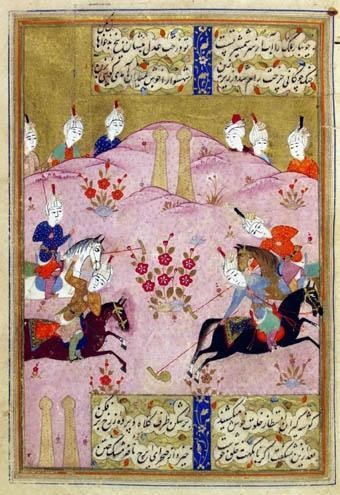 Source: http://old.mnw.art.pl/index.php/pl/zbiory/zbiory_studyjne/zbiory_sztuki_orientalnej/kolekcja_sztuki_islamu/
Source: http://old.mnw.art.pl/index.php/pl/zbiory/zbiory_studyjne/zbiory_sztuki_orientalnej/kolekcja_sztuki_islamu/Fragments of the game were periodically presented on ancient manuscripts, as well as detailed descriptions and rules of the game. Various antique prints and ceramics suggest that sport has a long history. For example, a vessel with images of Chovgan was found during archaeological excavations in the Oran-Gala area, indirectly suggesting that the game existed in the 11th century around the city of Beylagan. Mention of Chovgan also appears in 'Khosrow and Shirin', a poem by the writer and thinker Nizami Ganjavi, and on the pages of the epic tales 'Kitabi Dede Korkut' and 'Kitabi Dede Gorgud'. Miniatures for the poem "Khosrov and Shirin" dated to the ХI century, as well as miniatures of Tabriz, illustrate various game scenes.
Photo: A 16th century miniature depicts a chovqan game the story of Khosrow and Shirin of Nizami Ganievi
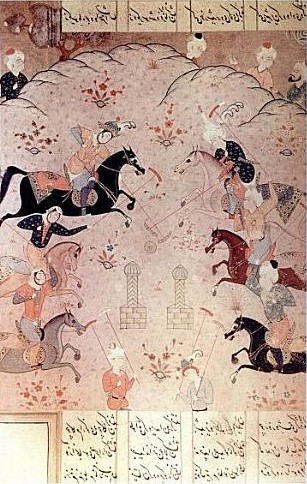 Source: Singh Jaisal (2007), Polo in India, London: New Holland, p. 15.
Source: Singh Jaisal (2007), Polo in India, London: New Holland, p. 15.Historically, Chovqan was widely played by the aristocracy of Azerbaijan and members of the Shah family. The game required specifically trained fast and short horses. That is the reason why it was so popular in Karabakh, where breeders focused on producing the best horse breeds, including the famous Karabakh breed. The first international Chovqan competition among the Middle East took place in the 2nd century in Baghdad.
Photo: Shah Mahmud, A polo game: an illustration from the poem Guy u Chawgan (the Ball and the Polo-mallet) (F1935.18, manuscript). Dafavid dynasty. Color and gold on paper, H: 19.4 W: 12.3 cm. Tabriz, Iran.
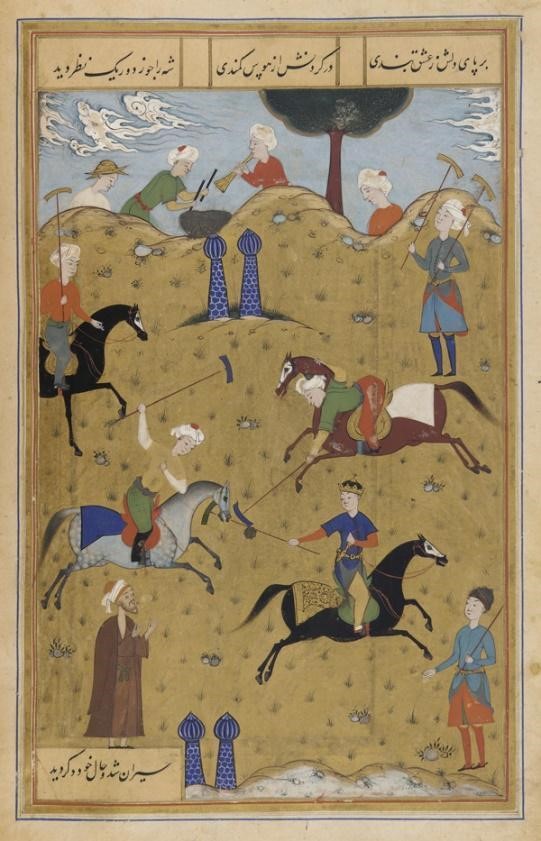 Source: The Freer Gallery of Art and Arthur M. Sackler Gallery of the Smithsonian Institution
Source: The Freer Gallery of Art and Arthur M. Sackler Gallery of the Smithsonian Institution
The Silk Road has popularized Chovqan in India. The English played a great role in the distribution and development of the game in Europe and around the world. Chovqan came from India to England in the nineteenth century and became very popular, and the addition of new rules promoted the rapid spread of this game in Europe and the USA. English have been responsible for creating name of the game – polo. It was included in the program of the Olympic Games in 1900 in Paris. Five teams from the three countries took part in the competitions.During the Soviet period, competitions of Chovqan often took place in Karabakh and other regions of Azerbaijan. In Karabakh, Chovqan was popular until the 1980s.
Chovqan was practiced from the end of the ninth to the end of the nineteenth century during various folk holidays, as well as part of the entertainment of the local nobility. From the end of the 19th century, a number of factors influenced its lower popularity, including decrease the number of players and good trainers, urbanization and exodus - pull out of Chovqan players from traditional places of practicing this sport, as well as a serious shortage of Karabakh horses and the liquidation of breeding horses used by Chovqan practitioners. As a result, the number of Chovqan players and the frequency of Chovqan competitions has decreased significantly.Photo: Polo game (Chovqan) – miniature from Tabriz.
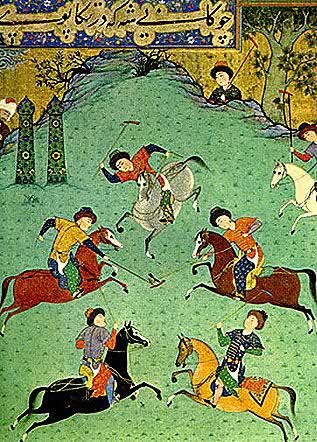 Source: Л. С. Бретеницкий, Б. В. Веймарн. Искусство Азербайджана IV—XVIII веков. — М., 1976.
Source: Л. С. Бретеницкий, Б. В. Веймарн. Искусство Азербайджана IV—XVIII веков. — М., 1976.Chovqan's practice has been significantly reduced due to the departure of many outstanding trainers over the past 30 years, such as Mahammad Musayev, Isa Suleymanov, Adil Badalov, Akbar Abbasov, Sabir Hasanov, Fikret Huseynov and others. Mahammad Musayev, Fikret Husayn and Isa Suleymanov were among the most enthusiastic trainers of Chovqan, they tried to attract young people, trained them and organized regular competitions. Their departure led to the complete disappearance of the Chovqan teams in Ganja, Karabakh, Khyzy, Shamakhi and Gedabey. In the Soviet period and early post-Soviet times, it was difficult to pay attention to Chovqan, because it was not treated as a heritage. After the collapse of the Soviet Union, the abolition of the kolkhoz system, most of the Chovqan players in Ganja, Karabakh, Khyzy, Shamakhi and Gedabey began to migrate massively to urban areas where it was easier to get an education and earn for a living.
- Description:
Two competing teams of players (called "tagymes") participate on a flat grass field 200 meters long and 120 meters wide. Each team consists of five (rarely six) riders and one in reserve. A team of five players has two defensive players and three attackers. For six players, each team has two people in the back, one in the middle and three strikers. Chovqan is umpire by three referees (main referee and two side referees), usually chosen from among the most experienced players. At the opposite ends of the field, two 3 m wide goals are placed, a half-meter drawn line of the penalty area has 6 m long . Players use specific wooden hammers (chovqans) prepared from elm, pomegranate, mulberry, dogwood or hornbeam. During the game, players try to strike a small (leather or wooden) ball into the opponent's goal with a hammer. The game starts from the center of the pitch or from where the goal was scored. The duration of the game is two halves of 15 minutes with a 10-minute break.
Chovqan competitions are usually accompanied by music performed on folk instruments such as zurna (in the form of a pipe), saz, nagara and def (a kind of drums). This instrumental folk music, called janghi, is played at the beginning and end of the game, and sometimes - after scoring each goal. Janghi musicians are actually folk musicians who are quite numerous in Azerbaijan. Accompanying music, an atmosphere of joy and Christmas (a time when competitions often take place) contribute to the popularization of Chovqan.Chovqan players and trainers are mostly local farmers who only practice Chovqan as an amateur activity. To participate in the competition, each player must have sufficient skills. Sometimes trainers are also responsible for creating teams. The sport requires a lot of experience and physical strength. It is not easy to sit in the saddle, grab the bridle, lean and try to hit the ball at the same time. The player must feel his unity with the horse to gain full control over the situation. There is no age limit for Chovqan players, as long as they have a good health condition. Chovqan players traditionally wear a large Astrakhan ("shepherd") hat, chukha (outerwear worn on the shoulders), arkhalyg (long tight coat with a short waist and gathered on the belt), belt, special pants, socks and shoes (charygs). In summer, players wear lighter clothes (silk shirts with national ornaments, pants made of delicate materials and light shoes). During the competition, Chovqan players can choose traditional clothes of the same color to show their team affiliation.
Knowledge of Chovqan, its detailed rules, skills and techniques are transmitted by experienced players ("trainers") for beginners verbally, through training conducted among players in local farms and riding facilities. Every future competitor must already be good enough in horse riding before starting training in Chovqan (riding skills are usually passed on to farmers' families). Coaches teach beginners how to play in a team, how to maneuver during the game, better hold the stick, hit, move forward and hold the ball, how to better control the horse and ensure a proper balance of physical strength of both the player and the horse. Since the rider's success also depends on the horse's health, fitness and speed, Chovqan training also includes learning how to care for horses and how to improve riding skills: how to make him move quickly and stop before the ball, how to efficiently turn left and right, how fast return to the starting position.
Chovqan has evolved and developed in close connection with the breeding of Karabakh horses because Karabakh horses are considered physically best suited to Chovqan. The Karabakh breed of horses is distinguished by a compact silhouette, medium height and agility. These horses are not very tall (about 144-154 cm), well-muscled and have strong and short legs. Due to the height of Karabakh horses, Chovqan players can use a stick which is 125-130 cm long. A taller horse would cause his rider to use a longer one, which would technically complicate the game (which is also avoided for safety reasons). Using longer sticks would mean a departure from the traditional Chovqan principles.
The competition takes place in empty grassy fields, and players take care of the horses to avoid injury to animals and degradation of the environment as a whole. The duration of the game (two halves of 15 minutes each) is ideal to avoid excessive horse fatigue. - Current status:
Currently, this sport appears on the occasion of folk holidays, as well as individual interest of enthusiasts of it, mainly once a year during the annual Chovqan competition in Sheki. This competition was initiated by the Ministry of Culture and Tourism as an idea to support Chovqan. In 2005, the first Chovqan competition was organized in Sheki (at a horse-breeding center), the idea was to revive the public interest of this sport by involving other practitioners from various regions of the country as part of the annual competition. Since 2005, the Ministry of Culture and Tourism of Azerbaijan, in cooperation with its regional representatives and the National Horse Breeding Center, has been organizing the annual Chovqan competition in Sheki under the name "Presidential\Championships of Chovqan". Yanghi musicians also take part. Currently, the competition usually takes place in December, and 16 teams from different regions participate in it - Sheki, Aghdam, Agstafa, Gazakh, Balaken, Zagatala, Gakh, Oguz, Ismayilli, Baku, Yevlakh, Goranboy, Goygol, Barda, Dashkesen and Tovuz . Usually, these competitions congregate dozens of people of all ages who come to watch traditional sport and support their teams.
Sport is practiced, especially by members of the regional Chovqan teams. The most famous are two organizations: KHAA (Karabakh Horses Amateurs Association) and AEF (Equestrian Federation of Azerbaijan). The most experienced players are Alovsat Rajabli, Tamerlan Mehdizade, Nuraddin Atayev, Mushviq Mahmudov, Elvin Islamov, Elnur Husejnow, Kheyal Adburahmanov, Ilgar Mammadov, Etibar Mammadov, Mammad Aliyev and Natiq Orujov. It is worth mentioning other distinguished players and trainers, e.g. Rashad Samadov, Shamseddin Atayev, Ramil Nadirov and Namiq Orujov. Chovqan practitioners can also be found among members of the Karabakh and Eurasian Horses Association, as well as equestrian clubs such as "Gunay", "Sarhadchi" and "Murad".
Even if the organization of annual Chovqan competitions attracts the interest of local audiences and the media, participation statistics are not fully satisfactory.
According to the Register of Intangible Cultural Heritage of Azerbaijan, in 2010 the group of Chovqan practitioners in Azerbaijan numbered only 137 people (including trainers). Updated data provided by the regional departments of the Ministry at the beginning of 2012 show that this number has decreased to 118 people.
Such experienced Chovqan trainers as Rashad Samadov, Elvin Islamov (Gazakh), Elnur Huseynov and Natiq Orujov (Sheki) organize Chovqan training in various public and equestrian centers. However, they note that the interest of young people is decreasing and it is difficult to organize Chovqan teams. At the same time, coaches point out that many potential players avoid playing Chovqan because they believe that game security must be enhanced. The availability of training information is also low, and the training accessories and clothing of the Chovqan player are often quite expensive, which is also a big problem for players.Players believe that an important threat Chovqan is currently facing is the rapid decline of the Karabakh horse race - the best for this game. It was caused by a number of events in the 20th century, such as the closing of the horse-breeding farm in Khan and the Agdam hops in Karabakh, mechanization of work and agriculture, and (as a consequence) a sharp decrease in demand for horses, reduction of grazing areas and very poor veterinary services. At the same time, a number of Soviet government activities in 1930-1950, namely collectivization and Soviet tax policy (aimed at reducing the number of horses) caused almost complete neglect of horse breeding in Karabakh. Another factor was the lack of respect for the features of the breeds in the selection because this breed was too often crossed with Arabian and Dilbaz races. As a result, today the purebred Karabakh horses in Azerbaijan are estimated at 300; about 20% of them are used in Chovqan. The shortage of Karabakh horses available to Chovqan forced players to use mixed breed horses, which make a longer stick required, thus exposing the rider to danger and departing from traditional practice.
Photo: Karabakh horse.
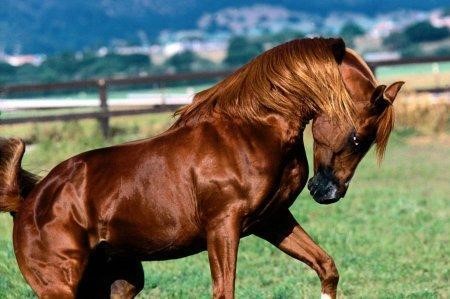 Source: http://uluses.com.az/gundem/2041-clin-d-oeil-sur-le-monde-azerbadjan-les-chevaux-du-karabakh.html
Source: http://uluses.com.az/gundem/2041-clin-d-oeil-sur-le-monde-azerbadjan-les-chevaux-du-karabakh.htmlThe liquidation of the Agdam hop factory in Karabakh in 1993 had a huge impact on Chovqan practice because it was the center of Karabakh horse breeding in their historical surroundings. The factory was then settled in the Barda region, but the agro-ecological conditions of the latter are not the same. In addition, Barda (compared to Agdam) does not have so many Chovqan fields available because local horse club/breeding centers have not created such fields.
The number of Chovqan practitioners dropped from 137 to 118 in 2012 compared to 2010. However, since then it has been showing increasing dynamics. In 2013, the number of players, coaches and referees Chovqan was estimated at 255 people, and in 2017 at 280 people. In addition to 16 existing teams, in 2013-2017 new ones were created, e.g. "Polad", "Govsar", "Serhedchi", "Lachin". Janghi musicians are also enjoying increasing popularity in competitions. - Importance (for practitioners, communities etc.):
Chovqan strengthens the sense of identity rooted in nomadic culture and associated with the perception of the horse as an integral part of everyday life. Chovqan's detailed rules, skills and techniques are passed from experienced players to beginners through collective training.
For both the public and players, Chovqan is part of the national living heritage. It strengthens the sense of identity, rooted in the nomadic culture, in which one of the important aspects is the perception of the horse as an integral part of everyday life. For Chovqan practitioners, the game is not just a physical exercise inherited from their ancestors: they say that the game strengthens the sense of cultural belonging, makes them lead a healthy lifestyle, achieve harmony with horses and develop determination in individual development.
Being constantly practiced and based on the principles of equality, Chovqan serves to connect people, teaches teamwork and helps to respect the success of others. As Chovqan practitioners note, it is important to understand that in Chovqan, the rider and his horse complement each other and form a unity. The problem arising from one part of this unity is already a threat to the whole.In the years 2007–2008, the Azerbaijani government passed an act on the development of horse breeding and adopted the "National Horse Breeding Program", which qualified the Karabakh horse breed as endangered. The program provides long-term measures to protect horses in Karabakh as a race. These measures include pedigree analysis, gene pooling and selection, and prohibit their export or sale abroad. One of the expected results of the Karabakh horse breeding program is to increase their number by 30% in ten years, as well as to increase their participation in traditional equestrian sports.
The protection of this traditional sport is also demonstrated by the classification of Chovqan as a living cultural tradition and its inclusion in an action plan for the protection of the intangible cultural heritage in Azerbaijan (ordinance No. 259 in 2009).
On April 28, 2010, based on inventory data provided by the Chovqan group of practitioners, this traditional sport was included in the Intangible Cultural Heritage Register, prepared and maintained by Azerbaijan's Ministry of Culture and Tourism, under registration number FT010100007.Chovqan's inclusion on the UNESCO World Heritage List has been received with great enthusiasm by many communities in Azerbaijan. This increased interest of the sport, as well as a sense of identity, cultural belonging and recognition of the nomadic culture. This breed of horses in Karabakh is perceived as an integral part of this culture.
This inscribing was received with great enthusiasm also because it is seen as a symbol of the cultural reunion with the occupied territories, many people believe that sport was born in Karabakh. In this sense, this process strengthened the sense of cultural belonging of practitioners, many of them considered the need to leave Karabakh as a forced eviction.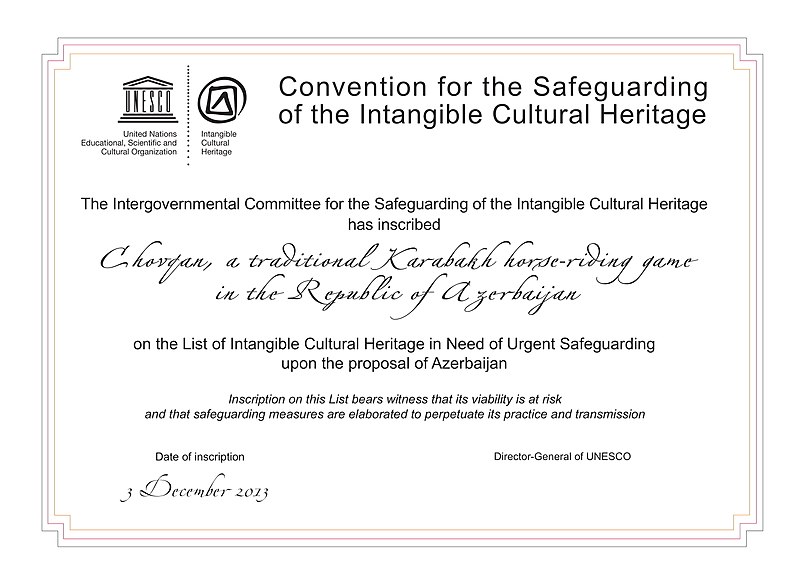
Chovqan audience is increasing because the sport is gaining more popularity among young people. In 2014, the total number of spectators was estimated at 5,000-6,500, in 2016 Amateurs Karabakh Horses Association reported about 7,500-8,500 spectators coming to watch the Chovqan competition the following year.
The shortage of horses in Karabakh, best adapted to Chovqan and valued for strength and agility, remains one of the major challenges for the development of the sport. Despite the efforts of public institutions and NGOs, Karabakh horses are still very difficult to breed, which is important for keeping the breed clean. - Contacts:
In the 1960s, some experienced Chovqan practitioners began promoting this sport by organizing and participating in competitions at the national level. These activities lasted only a few years.
The Azerbaijan Equestrian Federation (AEF) was founded in 1996, and the Karabakh Horses Amateurs Association (KHAA) in 2006, where Chovqan practitioners are a key group, which ensures the continuity of its activities.
The main goal of Chovqan players from both organizations was to gather, on an amateur basis, players from neighboring regions around Sheki who are still practicing Chovqan and organizing competitions (regardless of the age of the players). An important aspect of organizations' activities is also passing on the Chovqan tradition by organizing training in local horse breeding centers (in total there are 4 centers).
In addition to KHAA and AEF activities, many experienced players from Chovqan have initiated their own training sessions. In Gazakh and Sheki, trainers like Rashad Samadov and Elvin Islamov organize group sessions for young Chovqan players.Karabakh Horses’ Amateurs Association
144 A Azadlig avenue, Baku, AZ1106
Tel. (+99412) 4998622
Fax (+99412) 4998624
Email:This email address is being protected from spambots. You need JavaScript enabled to view it. Azerbaijan Equestrian Federation
Bina settlement, Mardakan highway, Bina Equestrian Center, Baku AZ 1045, Azerbaijan
Tel. (+99 412) 565-31-51
Fax (+99 412) 565-31-52
Email:This email address is being protected from spambots. You need JavaScript enabled to view it.
Webside: http://www.araf.azSarhadchi Equestrian Centre
Novkhani settlement, 2017
Baku, Caucasus
1119 Azerbaijan
+ 994 12 448-20-17 - Sources of information :
● Çövkan oyunu (yarış qaydaları) (The Chovqan Game (traditional game rules)), Kirovabad, 1960.
● Akif Aliyev “Azərbaycam Milli İdman oyunlarının tarixi” (“History of traditional games of Azerbaijan”), Baku, 2001
● X. Rajabli, A.Orujov, E.Gadirov and others “Qarabağ cinsli atların Dövlət Damazlıq Kitabı” (State Gene Pool Book of Horses of Karabakh Breeds ) Baku, 2006.
● Hajibala Agayev “Azərbaycan Milli xalq oyunları” (National games of Azerbaijan), Baku, 1992
● Dadashzade Mammad “Azərbaycan xalqının orta əsr mənəvi mədəniyyəti” (Spiritual culture of the people of Azerbaijan in the Middle Ages), Bakı, 1985
● A. Sh. Hashimov, F.V. Sadiqov “Azərbaycan xalq pedaqogikası” (Azerbaijan folk pedagogic), Bakı, 1993
● Fikret Hüseynov “İgidlik və gözəllik oyunları” (Bravery and beauty games), Bakı, 1966
● Fikret Hüseynov “Azərbaycan atçıları və atüstü milli oyunlar” (Azerbaijani Horsemen and National Horse Riding Games), Ecology printing house, Ganja, 1998.
● Kh. Agayeva, 1976, “Gənclər at çapmağı sevirlər” (Youth is good at galloping), İdman newspaper, N 55
● A. Guliyev, 1970, “Cıdır meydanında” (“On the racing field”), Sovet kəndi newspaper, N 76, 30 June, page 1
● Parviz Aliyev, 1983, “Yürüş ənənəvi olacaq” (“Competition will be legendary”), İdman newspaper, N 123, 14 October
● Nizami Gəncəvi “Xosrov və Şirin” poeması – the Khosrov and Shirin Poem of Nizami Ganjavi
● Firdowsi Zamanov, 1972, “Qır atın şöhrətini yaşadaq” (Let us keep the rural fame alive), Kommunist newspaper, N 226, 26 September
● Ahmad Isayev, 2004, “At belində keçən ömür” (Live spent on a horse), N 58, Azerbaycan newspaper, 7 September
● Sabutay, 2008, “Çövkən - ərənlərin oyunudur” (Chovken: a game for the brave ones), Medeniyyet journal, 25 December
● Jeyhun Zarbaliyev, 2011, “Çövkən: at belində şücaət” (Chovken: courage of the horse-rider), Medeniyyet journal, 11 MayVideo:
https://www.youtube.com/watch?v=GeFMC2LNSyM
https://www.youtube.com/watch?v=Z-1XFqTBrUw - Gallery:
- Name of sport (game): Chundan Vallam
- Name in native language: Chundan Vallam ("Beaked Boat", Malayalam ചുണ്ടൻ വളളം)
- Place of practice (continent, state, nation):
Kerala, India
- History:
Chundan Vallam originated in the 14th century during a war between feudal kingdoms and the kingdom Chembakasseri wasn’t doing too well in this war. So King Devanarayan of Chembakasseri consulted the ancient texts of Sthapathya Veda, a form of traditional architecture linking people to the buildings which they occupy, and thus the King came up with the idea of Chundan Vallam. These massive canoes were designed to hold over 100 paddler-warriors and hold cannons. The ancient design of these boats has survived the centuries as they are still built to the same blueprint over 700 years ago. Overtime, the main use of the boats has moved away from the traditional naval warfare purposes to more of a cultural event, and they no longer carry cannons.
- Description:
Each snake boat belongs to a village along the banks of the river Pampa. Every year the boats are oiled mainly with fish oil, coconut shell, and carbon, mixed with eggs to keep the wood strong and the boat slippery in the water. The village carpenter carries out annual repairs and people take pride in their boat, which is named after and represents their village.
Constructed according to specifications taken from the Sthapathya Veda, an ancient treatise for the building of wooden boats, these boats vary from 100 to 138 feet in length. With the rear portion rising to a height of about 20 feet, and a long tapering front portion, it resembles a snake with its hood raised. Hulls are built of planks precisely 83 feet in length and six inches wide. The boats are a good example of ancient vishwakarma' prowess in naval architecture.
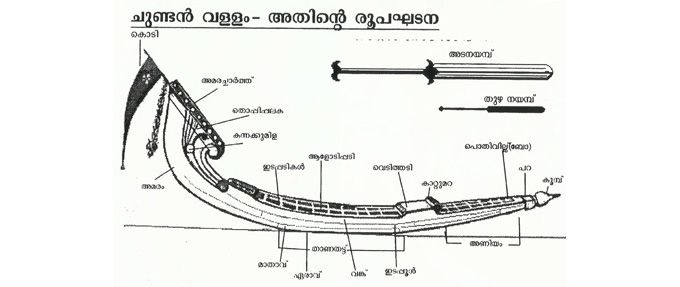
Traditionally a boat will be commanded by a village leader (kaarnavan or karanaadhan) with first adanayampu, and under him there will be three main paddlers who control the movement of the boat with a 12-foot-long (3.7 m) main rudder-oar (adanayampu). Sitting two to a row along the length of the boat, there will be 64 paddlers, representing 64 art forms (or on occasion 128 paddlers). They row in rhythm of the vanchipattu ('boat song'). There will be around 25 singers in a row at the middle between the paddlers. In the middle of the second half of the boat is a platform for eight people to stand from where the cantor will lead the song. They represent the Ashtadikpalakas (Devas or gods who guard the eight directions).
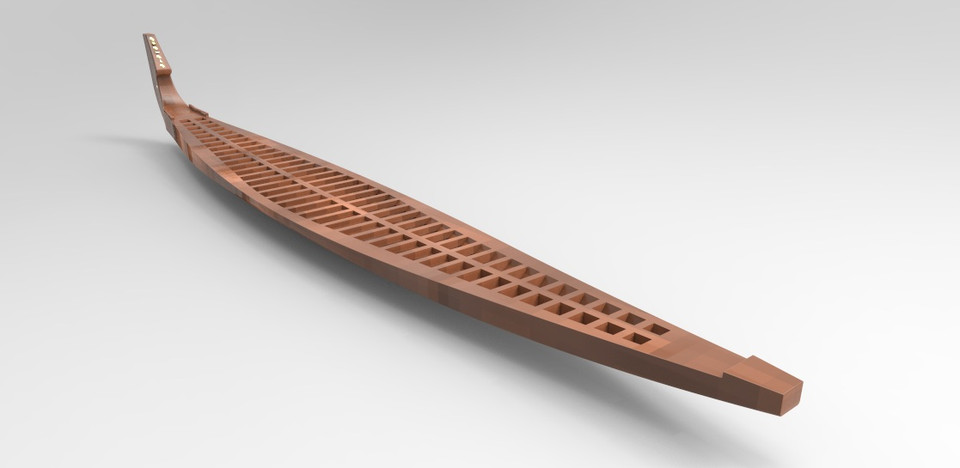
There are several sizes of boat, and there are often teams of over 100 people. The majority of teammates are paddlers, starting off in single file at the narrow bow of the boat, then double file near the front and the stern. The paddlers in the middle are separated by the central fire platform, which would hold a cannon during battle. Today, a couple men stand on the fire platform, beating it with poles, and surrounded by others singing the Vanchippattu, traditional folk songs about paddling, life and the gods. The beat of the poles and rhythm of the Vanchippattu keep the paddlers in time, while it is at the tail where the bot keeps going in the right direction. The boats are commandeered by a chief, who occupies the highest position on the tail, flanked by a team of Amarackars (helmsmen) who steer the boat to victory.
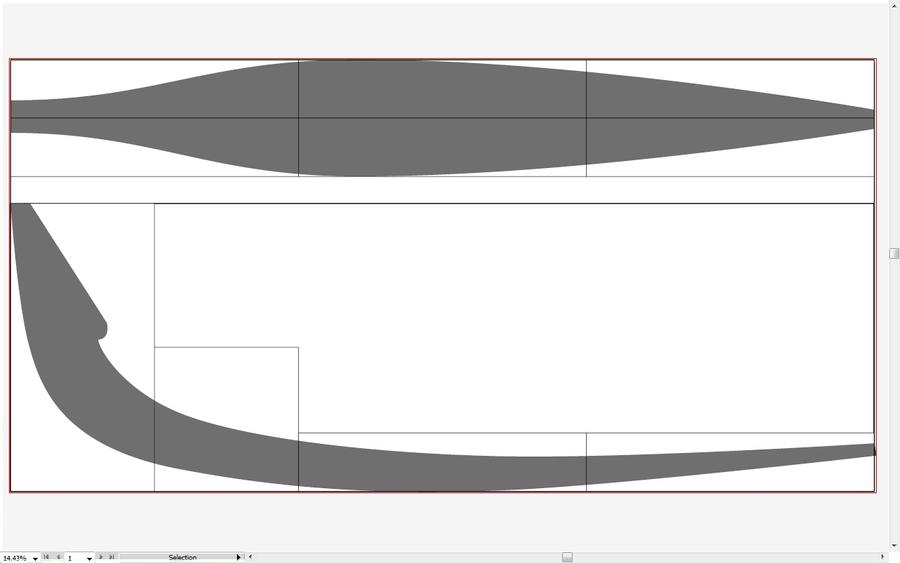
- Current status:
The Aranmula Boat Race takes place at Aranmula, India near a temple dedicated to Lord Krishna and Arjuna. Thousands of people gather on the banks of the river Pampa to watch the snake boat races. Nearly 30 snake boats or "chundan vallams" participate in the festival. The oarsmen sing traditional boat songs and wear white dhotis and turbans. The golden lace at the head of the boat, the flag and the ornamental umbrella at the center make it a show of pageantry too.
Today Chundan Vallam tradition has strong religious and spiritual significance and the boats are often worshipped like deities. To this day, all people on board must be barefoot, and only men are allowed to touch the boat.
- Importance (for practitioners, communities etc.):
Chundan Vallam, also known as snake boat racing is intertwined into community and culture of the backwater state of Kerala, India. With teams usually consisting over 100 people, oftentimes 150 people, this is considered as the world’s biggest team sport. Common with most paddling sports, the timing of the stroke is at upmost importance as it only takes one person’s lag to to put out the timing of the whole boat, given the massive teams, all of whom must have perfect timing, this challenge is multiplied by every paddler and drummer being off the mark.
"The ferocity of your collective spirit pulses throughout your vessel with enough force to make Karthikeya, the Hindi god of war tremble in his boots. The beating of the fire platform pulses your through veins to every appendage of your body. Driving your paddle in perfect unison with your 127 teammates, propelling you boat forward and faster to the finish line. The pride of your village rides on your boat, they need this, they need a good harvest this year."
- Sources of information :
Making Of Kerala Chundan Vallam - https://www.youtube.com/watch?v=TRxnt5c1z1w
Nehru Trophy - https://www.youtube.com/watch?v=YFoKwIO6ytA
Chundan Vallam - https://www.youtube.com/watch?v=NXd8nqzqJQo
Chundan Vallam - https://www.youtube.com/watch?v=kyM813VluZo - Gallery:
- Documents:
 modelling-and-cfd-analysis-of-traditional-snake-boats-of-kerala.pdf
modelling-and-cfd-analysis-of-traditional-snake-boats-of-kerala.pdf
- Name of sport (game): Da-ga
- Name in native language: 打尜、打嘎
- Place of practice (continent, state, nation):
China
- History:
The history of da-ga is not well known. Some say it was invented 1000 years ago (Tang Dynasty).
- Description:
Da-ga is a bit like modern baseball. Some people call it “grandfather” of baseball. It has different names around the world:
Lippa (Italy), Billarda (Spain), Pandolo (Slovenia), Klipa, Kiczka or Sztekiel (Poland) etc.The Playing Field
For regulation games, the length of the field should be 50 meters long. The important lines are the base line and the sidelines. The overall surface is compacted or paved but not necessarily completely flat. You can also play on grassy surface, but then you may need a moveable firm base to place the Ga-ga for hitting.The Equipment
• Base - Originally it was a stony flat surface but for modern competitions they use a firm flat rectangle made from metal materials. It is placed on the baseline which is the line in the narrower part of the field.
• Bat/Stick– is a 55 cm long piece of wood with rounded ends.
• Ga – it is made from wood. On both of the edges it is shaped into a cone.
• Face protection – a protective shield for the face, which is usually made of plastic. All defence players should use this protection.
• Gloves – for protection of the defence players hands;
• Uniform – players of each team have their own uniform, although it is not required.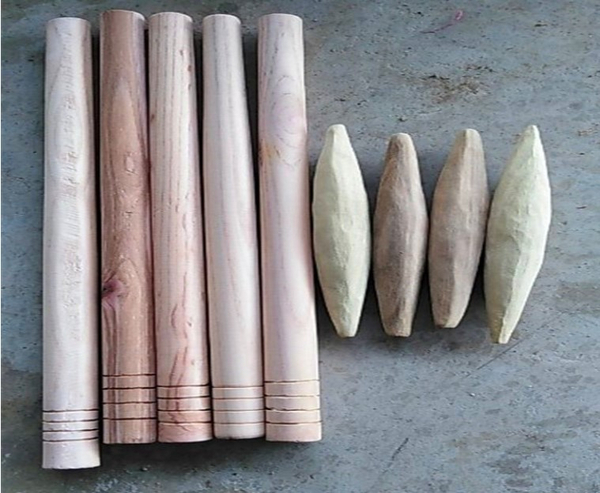
Teams
The game is played between two competing teams. Each team plays with three players.
In a game of Da-ga there is also a referee. He must not interfere, unless a team has something to object or the play is too slow. In that case he solves the conflict on the base of the rules or simply warns the players to speed up the game. There are even yellow and red cards to punish bad words or insulting other team players.
Playing the Game
Goal of the game
The goal of the game is to score as much points as possible by hitting the “ga” towards the end of the playfield. The team that has more points at the end of the game is the winner.
Game segments
The game is played in rounds. In each round, both teams take part in attacking and defending. The toss of a coin before the start decides which team will start first on the offensive side and which in the defence.
Only the attacking team has player active on the playing field while the other team-mates are watching. On the other side, the whole defending team is active on the field. When the first player completes his turn, he is replaced with the next player from the attacking team. When all the offensive players have finished, the teams switch places – the defending team becomes the offensive team and the offensive team goes to the defence. The game then continues until all of the new offensive team's players have finished playing. Then it’s the end of the first round.
In the second round everything repeats. The only difference is that the first attacking team now starts in defence.
Flow of the Game
Every active player completes his active role if not prematurely struck out, in the following phases of the game:
Phase One – Active game of the first player
The first step is to toss the ga into the game or “service”. The defence team spreads out in the wide area of the field. No defence player, however, can be closer than 12-stick lengths from the base. The active player places himself maximum 1 stick far from the base. He holds the ga in his hand. When the game starts, the active player:
- hits the base with the stick,
- then he shouts “Da-ga, Da-ga zero” so everyone on the field can hear,
- with his hand, he throws the ga straight up into the air and he hits it with the stick into the playing filed,
- if the ga doesn’t land in the field, he has two more attempts.
Phase Two – Catching the ga
The defending players tries to catch the ga in the air. If they succeed the active player has ended his turn. Otherwise the ga is stopped on the ground by defending players, or it stops somewhere in the field by itself.
Phase Three – Targeting the Base
From the point where the ga was stopped, one of the defence players tries to throw the ga to strike the base. The active player can defend the base only with the stick. If the ga anyway hits the base, the active player is struck out and he ends his turn. Otherwise the game continues.
Phase Four – Striking the ga
The active player that has not been struck out continues the game. The active player places the ga near the base (1 stick in length). The defence team players take their positions in the playing field and no closer than 12-stick lengths from the base. When everyone is ready, the active player places himself near the ga. With one hit, on the edge, the ga lifts in the air and with the second hit he sends the ga towards the end line. If the defending player doesn’t catch the ga in the air, the active player repeats the last step two more times.
Phase Five – Counting Points
The points are counted only if the active player has finished everything without the ga being caught in the air by the defending players.
The attacking team measures, by eye, the distance between the base and the ga. One of the players than loudly says the distance in the unit of stick.
If the defending team agrees with the distance the players scored as much points as the distance was. Otherwise they measure it using the stick from the ga to the base. If the attacking team said a bigger number then the measured, they lost all the points. If they said a correct or a smaller number, the points are doubled.
Second game and subsequent games of the first active player.
Other players that follow the first, play in the same way as mentioned before.
When everyone completes their turns, and the teams are changed, the second round starts. The rules are the same and each player has to attack once more. The end of the second round is the end of the game. The team with more points wins.
In the case of a draw, each of team members has one chance to hit the ga from the base. The winning team is the one that strikes the ga further out than the other team. If both teams strike the ga beyond the end line, the ga striking continues until one team wins by striking the ga further out into the confines of the playing field.Concluding the game
At a tournament, the game is normally played in two groups. The first and the second team of each group passes to the finals where the first team plays with the second one of the other group. The winners then play the final game for the 1st place at the tournament. - Current status:
Practiced
- Gallery:
- Name of sport (game): Daito-ryu
- Place of practice (continent, state, nation):
Japan
- History:
An ancient system of unarmed and armed combat founded by Shinra Saburo Minamoto during the Heian period (794-1156) and perfected in battlefield warfare. The techniques were most fully systematized (some say modified) by Sokaku Takeda with sword and unarmed techniques practiced together. It was the first and only tradition focused upon aiki-jujitsu. While it has inspired many succeeding disciplines, including aikido founded by Morihei Usehiba (Takeda's student from 1911-1918), daito-ryu proponents suggest that while the other systems share aiki jujitsu nomenclature, the understanding of aiki, as well as the techniques themselves, they may in fact be very different. See: aiki, Daito-ryu aiki jujitsu.
Daito Ryu lays claim to being the oldest aiki-jujitsu in Japan. It is a cultural treasure that in addition to being the progenitor of modern aikido has greatly influenced many modern other cognate budo disciplines (disciplines derived from warrior arts). It began its development when Shinra Saburo no Minamoto (1045-1127), a relation of the Emperor Seiwa who was to become the governor of Kai (modern Yamanashi Prefecture), studied the body's secrets by dissecting cadavers. He researched the body's weak points in order to discover how most effectively to attack them with a sword and how to apply locks to its joints. He further learned how muscles support the skeletal structure. The knowledge was passed to his descendants in the Takeda family of Kai and Daito Ryu was further developed there until the death of the family's most famous
General, Takeda Shingen in 1573.
In the mid-seventeenth century Takeda Kunitsugu, a relative of Takeda Shingen, became a senior counselor to the son of Tokugawa Hidetaka, Lord Hoshina Masayuki of the Aizu Han. Daito Ryu was combined with the Aizu Han's oshiki uchi techniques and became the method of self-defense for all Daimyo of the Aizu and those responsible for their protection. Daito Ryu continued to be passed from generation to generation within the Takeda family.
Takeda Sokaku Sensei formalized and named modern Daito Ryu Aiki Jujutsu. With his knowledge and skill in Daito Ryu and Ono-ha Itto Ryu Kenjutsu (Sokaku den), he traveled all over Japan on foot, teaching and meeting all challengers until his death in Aomori Prefecture in 1943 (Showa 18) at the age of 89. In Sokaku's 70 years of martial travels he remained undefeated, leaving behind an exceptionally rich curriculum of techniques and his mark on the history of Japanese Classical and Modern Martial Arts. Takeda Tokimune Sensei, Takeda Sokaku's son, organized the curriculum of some 2884 techniques into a more readily teachable syllabus. Techniques up to the 5th degree black belt level are included in the Shoden (beginning level techniques) syllabus of 118 techniques plus many. These techniques are executed from both sitting and standing positions as well as against attacks from behind. Each level requires knowledge of a different set of essential principles if one is to master the techniques.
In addition, Daito Ryu waza are categorized as Hiden Okugi, Chuden, Okuden, Goshingo no te, Aiki no Jutsu, Daito Ryu Nito Ryu Hiden, Kaishaku Soden, Soden, and Kaiden. Only a very few Daito Ryu teachers have extensive knowledge of these techniques, and as of this writing all of these men are Japanese. Tokimune Takeda Sensei passed away in 1993. The present Soke (head of a school or tradition) of Daito Ryu is Takeda Seishu.

